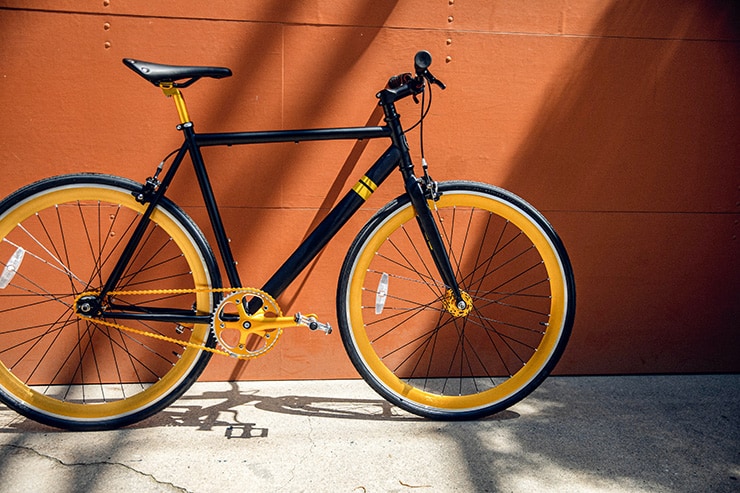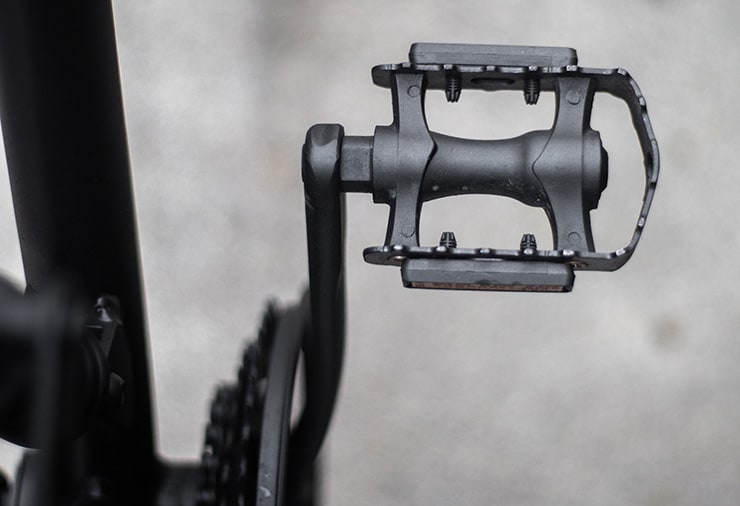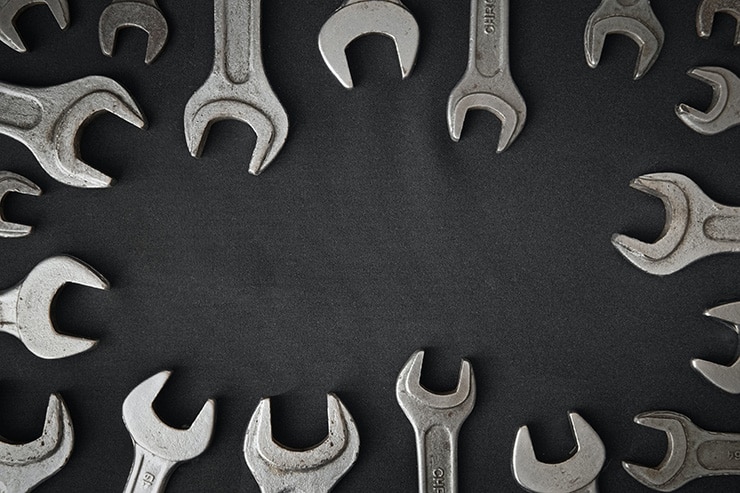Perhaps you’re building your own bike or simply want to try some new clipless pedals? Either way, you’ll need to know what wrench size to use for your bike pedals.
While the typical wrench size is 15mm, there are a few factors to consider.
The size will depend on your pedals and the type of job you’re doing. You will also need to consider what kind of wrench to use – a regular wrench or a specialized pedal wrench.
You may also need other tools like a hex key or a socket set.
This article will review everything you need to know about choosing the right wrench size (and the right kind of wrench) for your bike pedals.
Let’s get started!
Key Takeaways
- While the typical wrench size is 15mm, the specific size you need will depend on your pedals and the type of job you’re doing.
- You will also need to consider what kind of wrench to use – a regular wrench or a specialized pedal wrench.
- You may need other tools like a hex key or a socket set too.
- You can get away with using a regular wrench but a pedal wrench is easier to use, saves time, offers more leverage, lasts longer, and has a comfortable grip.
Do I Need a Specific Wrench Size To Change Bike Pedals?
The short answer is yes; you need a specific wrench size to change bike pedals. Most pedals are fitted using the same size pedal spanner or hex key, which is either 15mm or 8mm.
While there is a limited number and size of tools you can use, you will usually have a few different options to choose from for this kind of job. If you’re lucky, you will already have the right wrench at home.
Keep reading to find out what specific size you need for your bike.

What Is the Standard Wrench Size for Bike Pedals?
Even though not all bike pedals and jobs are the same, there is a basic size that will work for most jobs. The standard wrench size for pedals is 15mm.
However, there are two other common sizes that you may need, including a 6mm or 8mm Allen key.
How Do I Know What Size I Need?
While it is pretty simple to find the right wrench size for your pedals, there are a few factors that will determine the size and type you need.
To save time, you should consider the type of job you’re doing and what kind of pedals you have. Taking a few extra minutes to examine your bike will save you some frustration in the long run.
Pedal Type
Whether you have modern pedals or are rocking a vintage bike, you’ll need to find the right size of tool that works.
You’ll need a 15mm wrench if your pedal spindle has parallel faces between the crank and body.
Some older pedals will be a different size, such as 9/16 inch. However, these will still equate to a similar size of 14.28mm, so a 15mm sized wrench will work.
On the other hand, if you see a hexagonal socket shape at the end of your pedal spindle, a 6mm or 8mm hex key will work.
Job Type
If you are planning to install, adjust or remove your bike pedals, there are a few tools that could work for this.
- 15mm open-ended wrench. An open-ended wrench set is always good to have on hand when adjusting or removing pedals. If you need to loosen or tighten the derailleur bolts, handlebar stem bolts, quill stem bolts, or the wheel nuts, a 15mm open-ended wrench will be your best bet. (Try to avoid an adjustable wrench as these are typically too wide for a bike pedal.)
- Long-handled pedal wrench. A 10 or 12 cm pedal wrench will be a lifesaver when working with stuck pedals. The longer handle will offer more leverage, making the job easier. You can also use an extension to enhance the hex socket.
- Other types of pedal wrenches. If you are working with a pedal that is larger than average, you may need to use a 15mm or 17mm pedal wrench.
When working on the pedal’s internal parts, you will need a 2 or 3mm Allen wrench. Ideally, you should have an Allen wrench set on hand that spans from 2mm to 10mm. This will cover all the jobs you may be doing.
Can I Use a Regular Wrench for Bike Pedals?
If you’re looking to swap pedals or tighten a few parts, you may be wondering if you can save some money and use your trusty Allen wrenches for the job.
So do certain pedals require special wrenches? Not really.
You can usually get away with a regular wrench; however, there are some reasons you may want to invest in a pedal wrench. Let’s go over those below.
Reasons To Invest in a Pedal Wrench
A pedal wrench is an open-ended tool designed to fit the narrow wrench flats that you find on most pedals. Whether you’re working with a mountain bike or road bikes, this tool will work like a breeze.
Here are a few reasons you may want to invest in a pedal wrench:
- Offers more leverage. One of the main advantages of this tool is that it offers more leverage. Its long handle will make it easy to tighten those new pedals.
- Easier to use. Using this tool makes pedal removal simple. A pedal wrench is easier to use as they offer better grip and will get the job done twice as fast compared to a 6mm Allen or a crescent wrench.
- Saves time. Investing in a pedal wrench will help save time, especially if you work on your pedals a lot. Compared to other universal tools, pedal wrenches are much more efficient.
- Long-lasting. Your typical pedal wrench will be highly durable, as they are designed to do tough jobs like removing pedals. Most of these tools are made of strong steel that will prevent them from deforming.
- Comfortable grip. Whether you want to loosen or tighten your pedals, you can be sure that your hand won’t be sore after the job. Your average pedal wrench will come with a comfortable grip.

Are All Pedal Wrenches the Same Size?
Before you invest in a pedal wrench, you may be wondering if they are all the same size. Most pedal wrenches will come in the standard size of 15mm.
However, many pedal wrenches are double-sided and will offer three different sizes, including 15, 16, and 17mm. So even if you aren’t sure what size you need, the tool should be compatible with your pedals.
If you’re looking for a generic and affordable pedal wrench, check out the Nainsect Double Sided Pedal Wrench.
How to Install, Adjust or Remove Bike Pedals
You should now be confident in finding the right size of wrench. However, now that you know more about sizes, you may be wondering how to go about installing, adjusting, or removing bike pedals.
Knowing how to do these jobs properly is key; you need to make sure your pedals tighten correctly (especially if you partake in hill climb racing). Failing to do so may lead to problems and safety concerns.
Read below for some basic instructions on how to get these jobs done.
How To Determine the Left Pedal From the Right
The first thing you should know is how to differentiate the right pedal from the left.
This distinction is important as the pedal threads are different between the left hand side and the right.
The right pedal will have a right-hand thread, meaning you need to turn clockwise to install and counterclockwise to remove.
The left hand pedal will have a reverse thread (left hand thread) and tightens anti clockwise.
To make things easier, your bike’s pedals will be labeled with an “L” or an “R,” indicating whether it is the right or left pedal.
Installing Bike Pedals
The first thing you want to do is grease both pedal threads. Then start with the right pedal and thread it into the right crank end.
Now that it’s in, make sure it’s tight. Use a pedal wrench, Allen key, or an Allen wrench to tighten.
When tightening, make sure to place the wrench on the pedal flats. Hold the wrench handle with one hand and the opposite crank in your other hand, and tighten the pedal.
Now you will follow the exact same steps for installing the left pedal.
If you want a visual example of how to install bike pedals, check out the following video:
Removing Bike Pedals
If you’re ever going to buy a quality pedal wrench, this would be the job to use it for. It is much easier to loosen and remove pedals when you have a lot of leverage.
To remove a bike pedal, you first need to move the crank arm so that it is facing the front wheel. Make sure the wrench and crank arm is sitting at a 90-degree angle, and then place whatever instrument you are using on the pedal spindle.
Now you can try and loosen the thread and remove the pedal body.
If you have especially tight pedals, this part may take a bit of time. (To avoid difficult pedal removals in the future, make sure to put a thin layer of grease on the threads.)
You will complete the same process when working with the right side.
Adjusting the Internal Parts of Your Bike Pedals
Whether you need to replace or clean your bike’s bearings or axle, there are a few tools and wrench sizes you should have on hand.
The main set of tools you should have is a set of Allen wrenches. As mentioned above, you may need any size from 2mm to 10mm. You will also need a hex socket set to do this job. Any general set will do.
What Size are Bike Pedal Bolts?
A key piece of information to know before choosing a pedal spanner to remove pedals or work on the bike with, is what size the pedal bolts are.
Most bike pedal bolt threads are 9/16” x 20 TPI. Older models may be 14mm x 1.2 mm, while one-piece crank models are 1/2” x 20 TPI.
Do I Need Any Other Tools for Bike Pedals?
Now that we have covered the different wrench sizes you need for bike pedals, you may be wondering what other tools will come in handy. Here is a list of a few things to have on hand.
- Vise. If you ever need to work on the pedal itself, having a vise is a good idea. The vise will allow you to prop the pedal up and hold it steady while you work on it.
- Insulating cloth or vise protector. If you end up using a vise, make sure to have an insulating cloth or vise protector. These will protect the pedal itself from getting damaged.
- Allen wrench extension. Having a wrench extension is helpful when working with the crank arm. An extension will give you more leverage, making the job a lot easier.
Final Thoughts
To work on your bike pedals, you can do most jobs with a 15mm wrench or a 6mm or 8mm hex key.
Investing in a pedal wrench will make the job easier as they offer more leverage, are easier to use, are more efficient, and have a comfortable grip.
When working on the internal parts of your pedals, make sure to have an Allen wrench set and a hex socket set on hand.
We hope you found all the answers you were looking for today. Leave a comment if you enjoyed the article.

